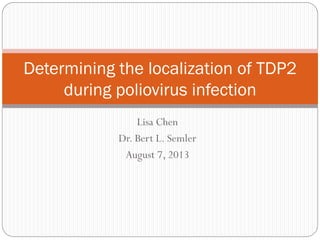
TDP2 research
- 1. Lisa Chen Dr. Bert L. Semler August 7, 2013 Determining the localization of TDP2 during poliovirus infection
- 2. History of poliovirus — Widespread in the early twentieth century — Tens of thousands were infected — Poliovirus vaccine was first tested in 1952 by Jonas Salk — Since then, the number of individuals infected by poliovirus each year has declined from hundreds of thousands to less than a thousand today — Although poliovirus is wiped out of most first world countries, outbreaks remain common in undeveloped areas in SoutheastAsia and Africa Image taken from Travelers Disease Information. N.p., n.d. Web.
- 3. Poliovirus overview — Belongs to the Picornaviridae family — Includes: coxsackievirus B3 and human rhinovirus — Is the prototype picornavirus — Has a small (~7-8 kb) single-stranded, positive-sense RNA genome — Completes its entire life cycle in the cytoplasm of infected cells — Due to its limited coding capacity, it uses host proteins for viral translation and RNA replication Three dimensional structure of poliovirus (Hogle et al., 1985)
- 4. 5’ tyrosyl-DNA phosphodiesterase (TDP2) — Is a cellular DNA repair enzyme — Repairs topoisomerase-mediated damaged DNA — Can be found in the cell cytoplasm but is predominantly a nuclear enzyme — Cleaves a unique viral protein-RNA covalent linkage in poliovirus infected cells — Previous studies show thatTDP2 becomes relocalized from the nucleus to the cytoplasm during peak times (4 hours post-infection) of viral replication — TDP2 remains at the cell periphery, a site distinct from putative viral replication complexes
- 5. TDP2 relocalizes to the cytoplasm during poliovirus infection — TDP2: — Is predominantly a nuclear enzyme — Begins to relocalize from the nucleus to the cytoplasm 2 hours post-infection — Relocalizes to the cell periphery during peak time in poliovirus replication Virgen-Slane et al., 2012
- 6. Experimental Question — Where isTDP2 localized in poliovirus-infected cells following peak times of viral replication? Hypothesis — TDP2 will remain in the cell periphery of the poliovirus- infected cells following peak times of viral replication
- 7. Specific aim — Determine the localization of TDP2 in poliovirus- infected cells following peak times of viral replication (5 and 6 hours post-infection) Method Image taken from Hart and Shears, 1997 — Use immunofluorescence to detectTDP2 and poliovirus protein 3A in poliovirus-infected cells
- 8. Figure 1. Determining the poliovirus titer for immunofluoresence Mock Infected 10 -7 10 -8 10 -9 Figure 1. Determining the poliovirus titer for immunofluoresence. HeLa cells were grown on 60 x 15 mm plates.They were then infected with decreasing 10-fold dilutions of poliovirus 1 (P3) stock and incubated for 30 minutes at room temperature to allow for viral adsorption.The cells were overlaid with 2% agrose-DMEM supplemented with serum and incubated at 37o C for 48 hours.The cells were stained with 0.1% crystal violet and the plaques were counted.The poliovirus 1 (P3) stock’s viral titer was calculated to be 8 x 10 -9 PFU/ml.
- 9. Mock5Hours6Hours TDP2 3A DAPI Merged Figure 2. TDP2 is found in both the nucleus and cytoplasm following peak viral replication Figure 2. TDP2 is found in both the nucleus and cytoplasm following peak viral infection. HeLa cells were infected with poliovirus 1 (P3) at an MOI 20.The cells were then fixed at 5 hours or 6 hours post-infection with 3.7% formaldehyde.The fixed cells were blocked with donkey serum, stained with αTDP2 (1:150) and α3A (1:500), and fluorescently labeled with goatαrabbit (1:1000) and goatαmouse (1:1000) respectively. Images were taken on the confocal microscope.
- 10. Summary — Since poliovirus has a limited coding capacity, it uses host proteins, such asTDP2, for viral translation and RNA replication — Previous studies show thatTDP2 becomes relocalized from the nucleus to the cytoplasm during peak times (4 hours post-infection) of viral replication — Conclusion:TDP2 can be found in both the cytoplasm and nucleus of poliovirus-infected cells following peak times (5 and 6 hours) of viral replication — Future directions:Determine the mechanismTDP2 employs to relocalize during poliovirus infection
- 11. Acknowledgements — Dr. Bert L. Semler — Sonia Maciejewski-Flores — Cancer Research Institute — Nita Driscoll — Patty Depetris
